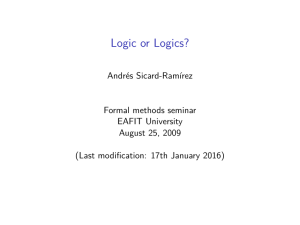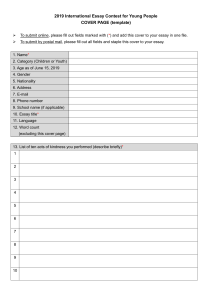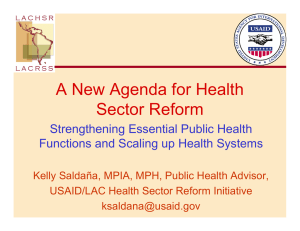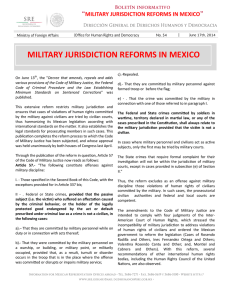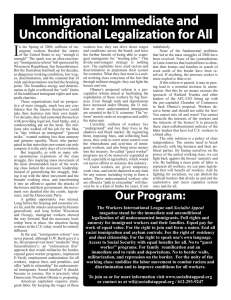Structure, Agency, & Education Policy Implementation
Anuncio
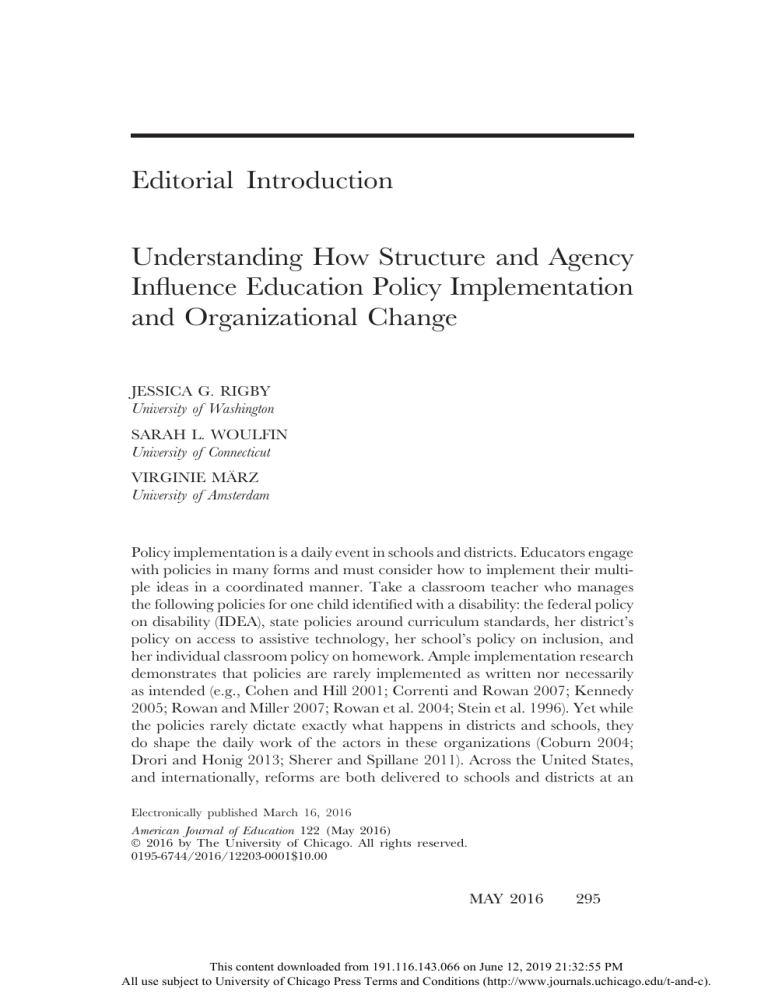
Editorial Introduction Understanding How Structure and Agency Influence Education Policy Implementation and Organizational Change JESSICA G. RIGBY University of Washington SARAH L. WOULFIN University of Connecticut VIRGINIE MÄRZ University of Amsterdam Policy implementation is a daily event in schools and districts. Educators engage with policies in many forms and must consider how to implement their multiple ideas in a coordinated manner. Take a classroom teacher who manages the following policies for one child identified with a disability: the federal policy on disability (IDEA), state policies around curriculum standards, her district’s policy on access to assistive technology, her school’s policy on inclusion, and her individual classroom policy on homework. Ample implementation research demonstrates that policies are rarely implemented as written nor necessarily as intended (e.g., Cohen and Hill 2001; Correnti and Rowan 2007; Kennedy 2005; Rowan and Miller 2007; Rowan et al. 2004; Stein et al. 1996). Yet while the policies rarely dictate exactly what happens in districts and schools, they do shape the daily work of the actors in these organizations (Coburn 2004; Drori and Honig 2013; Sherer and Spillane 2011). Across the United States, and internationally, reforms are both delivered to schools and districts at an Electronically published March 16, 2016 American Journal of Education 122 (May 2016) © 2016 by The University of Chicago. All rights reserved. 0195-6744/2016/12203-0001$10.00 MAY 2016 295 This content downloaded from 191.116.143.066 on June 12, 2019 21:32:55 PM All use subject to University of Chicago Press Terms and Conditions (http://www.journals.uchicago.edu/t-and-c). How Structure and Agency Influence Policy and Organizations alarming rate, and educators are left to prioritize and integrate them (Cuban 1990; Payne 2008; Smith and O’Day 1990). At the same time, scarce resources are used to support these reforms, and many outcomes remain uncertain (Hess 1999; Newmann et al. 2001; Tyack and Cuban 1997). These policies matter for the daily work of practitioners as individuals who must make sense of new ideas and practices, hold on to their own sense of what is the right thing to do, engage with the consequences of accountability measures, and consider the specific needs of their students and communities (Datnow and Park 2009; Dee et al. 2013; Mintrop 2012; Plank and Condliffe 2013). The relationship between structure and agency is a perennial sociological question. Scholars who draw on structural accounts usually explain action as limited by economic, political, and social contexts, whereas those who draw on agentic accounts look for human motivation and understanding to explain behavior (Giddens 1979). Education policy implementation is a particularly fruitful topic to explore the interaction between structure and agency given the manifold and complex structures, multiple stakeholders, and ongoing need for improvement. Although the articles in this special issue each define structure and agency in particular ways, brief field-level definitions of the terms they use are a useful foundation. Structures are regular patterns that can both enable and constrain individual actions. Giddens (1979) defines structure as “rules and resources” (64), or the ways in which we understand how things should be done, practices organized around those understandings, and capabilities that support those understandings. Agency describes situated practices, or the temporal capacity of individuals to take actions (Archer 1996; Meyer and Jepperson 2002). Scholars that focus on structure attend to issues such as policies themselves (Mazmanian and Sabatier 1983), the influence of formal organizational structures (McDonnell and Elmore 1987), and the allocation of resources. In contrast, scholars that attend to agency study individual actors such as teachers (Achinstein and Ogawa 2006; Anagnostopoulos and Rutledge 2007) and students (Miron and Lauria 1998; Stefanou et al. 2004). Typically, a focus on either structure or agency also results in an emphasis on one organizational level, such as the macro, environmental level or the micro, classroom level. Although this type of research highlights particular sites and processes of policy implementation, it often ignores other potential conditions and interactions that may be instrumental in how policy plays out. In this special issue, we integrate structure and agency to understand policy implementation in educational settings. The educational system has become increasingly complex, with greater prominence and prevalence of nonsystem actors and heavier federal influence (Fuller et al. 2007; Labaree 1997; Rowan 2002; Sun et al. 2013). As a result, educational organizations encompass more actors and structures that shape the implementation of each policy and the everyday work of teaching, learning, and leading. To explore this compli296 American Journal of Education This content downloaded from 191.116.143.066 on June 12, 2019 21:32:55 PM All use subject to University of Chicago Press Terms and Conditions (http://www.journals.uchicago.edu/t-and-c). Rigby, Woulfin, and März cated policy environment, the authors explicitly explore multiple levels of the environment, the boundaries between these levels, and the interaction between structure and agency. Further, in accordance with the sociology literature (Cooney 2007; Giddens 1986; Sewell 1992), the articles use multiple conceptions of structure and agency to represent the increasingly complex environments of schooling. First, in “Stability and Change of Mentoring Practices in a Capricious Policy Environment: Opening the ‘Black Box of Institutionalization,’” März, Kelchtermans, and Dumay respond to the question of how structures, such as institutional logics, are translated, maintained, and disrupted by actors on the ground. These scholars draw together the approaches of neoinstitutional and sensemaking theories to analyze the mentoring practices in one school in Belgium. They investigate the role of mentors’ sensemaking in shaping responses to changes in the broader institutional environment. This article provides an international perspective on the evolving education system, exploring mentors’ professional role identity in the context of institutional change. The article explains how the implementation of a mentoring program installed a new logic of mentoring as a professionalized job and how mentors creatively employed elements of this new logic in their daily interactions. Second, Woulfin’s “Duet or Duel? A Portrait of Two Logics of Reading Instruction in an Urban School District” presents findings on the institutional logics of reading instruction in an urban school district. Drawing on neoinstitutional theory, this article highlights the interrelationship of the macrolevel structures of logics of reading instruction and microlevel practices in schools. In particular, the article centers on the logics reflected during the implementation of a new reading program. “Duet or Duel” depicts how two logics were enacted in practice in distinct ways by district leaders and coaches, portraying the complex ways in which district leaders advanced each logic and coaches hybridized the logics, with consequences for the direction of reform. Woulfin advances our understanding of how educators in different leadership positions engage with structures such as logics that exist in the environment and are carried into districts and schools by policies. In the third article, “Going Off Script: Structure and Agency in Individualized Education Program Meetings,” authors Bray and Russell use neoinstitutional and structuration theories to examine the individualized education program (IEP) meetings for five high school students identified with specific learning disabilities. This article explores how participants interacted during the IEP meetings and how learning, instruction, and postsecondary transition were discussed. The findings focus on the way in which the IEP document served as the dominant script, or structure, for the IEP meetings. This dominant script established roles for participation and influenced participants’ agency within the meetings. The authors also consider instances of disruption, in which particMAY 2016 297 This content downloaded from 191.116.143.066 on June 12, 2019 21:32:55 PM All use subject to University of Chicago Press Terms and Conditions (http://www.journals.uchicago.edu/t-and-c). How Structure and Agency Influence Policy and Organizations ipants exerted agency and went off script, breaking from the meeting structure. This piece advances our understanding of structuration by grappling with special education policy as structure while treating educators’ work as agency. In “Between Structure and Agency: Contextualizing School Leaders’ Strategic Responses to Market Pressures,” Jabbar attends to how competition for students operates in an education marketplace created by post-Katrina choice reforms in New Orleans. This article describes how a school’s position in its local market structure influences how it is represented and viewed as a rival by network competitors, and it explains how a school’s position in the network of competitors influences the possible and actual strategic actions that schools adopt in response to market pressures. Jabbar sheds light on the institutional and social structures that guide and constrain school leaders’ understanding and actions. Finally, Rigby’s “Principals’ Conceptions of Instructional Leadership and Their Informal Social Networks” uses social network analysis—a method particularly useful for studying social structures and relationships—to explore how the informal social networks of six focal principals enabled and constrained their access to ideas about instructional leadership. The article describes how first-year principals were connected to some ideas and not to others and explains which ideas in the environment became salient to the principals and which did not. This article also lays out how preparation programs matter for how the focal principals’ conceptualized instructional leadership. From a theoretical perspective, Rigby’s article contributes to our understanding of the relationship between structure and agency by elaborating on the influences of informal structure on individual agency. There are several themes evident across the articles in this special issue. First, they account for multiple levels of the institutional environment and illuminate how the relationship between structure and agency is apparent in the impact of the macrolevel on the meso- and microlevels. März, Kelchtermans, and Dumay, for instance, illustrate how shifts in institutional logics of mentoring (macro) enrich the understanding of local institutionalization as it operates through local actors’ agency (micro). They do so by shedding light on mentor teachers’ positions between the changing institutional and school context and by describing the mentors’ internal manifestations of a new mentoring logic. Similarly, in studying the interaction between logics of reading instruction and educators’ practices and beliefs, Woulfin focuses on instructional coaches’ work as spanners of the boundary between the district and school levels, characterizing how coaches encounter, enact, and transmit logics of reading instruction. To better understand what happens between the macrolevel (i.e., institutional ideas) and microlevel (i.e., school leaders’ understandings), Rigby focuses on what happens at the mesolevel, or the middle space between policy and indi- 298 American Journal of Education This content downloaded from 191.116.143.066 on June 12, 2019 21:32:55 PM All use subject to University of Chicago Press Terms and Conditions (http://www.journals.uchicago.edu/t-and-c). Rigby, Woulfin, and März vidual implementation. In particular, Rigby characterizes principals as a bridge between shifting institutional logics and enactments of instructional leadership in schools. Likewise, by focusing on school leaders’ roles and positions in the socially constructed market hierarchy, Jabbar elucidates how a school’s structural position in the broader organizational field influences its strategic actions. Finally, Bray and Russell show how the interplay between structure and agency is visible through the introduction of externally developed artifacts. They illustrate how the introduction of the IEP document influences participants’ agency within meetings and how participants go off script, breaking from the institutionalized structure of the meeting. Second, these articles use in-depth qualitative methods. Inspired by structuration theory, Bray and Russell opt for ethnographic methods to study how the IEP document structures the IEP meetings. Combining video recordings, field notes, and document analysis, they explain how the IEP document enables and constrains participants’ actions. To study the relationship between logics and activities, both Woulfin and März et al. combine semistructured interviews, observations, and document analysis using case-study methods. These permit the researchers to marshal evidence on actors’ sensemaking and interactions in a changing institutional environment and provide the scholars with fine-grained evidence portraying how organizations are places where people and groups make sense of and creatively use institutional logics. Rigby and Jabbar both apply a social network approach to understand in what ways informal structures of the mesolevel serve as the bridge between institutional ideas and individual agency. Rigby uses social network analysis to untangle how the nature of beginning principals’ informal social networks influenced their access to instructional leadership logics, whereas Jabbar uses social network analysis to explicate how school leaders’ positions in a network of competitors played a role in constructing the market hierarchy. Third, by addressing the positions and roles of leaders in education reform, these articles extend our understanding of leadership practices throughout policy implementation. The authors portray how agency is wielded by several types of leaders, including principals, coaches, mentors, and special education administrators. For example, Woulfin explores the brokering activities of reading coaches during instructional reform, Bray and Russell characterize the strategic work of special education leaders as they interact with teachers, and März et al. unpack how teacher leaders’ search for professional legitimacy contributes to further institutionalization of the new mentoring logic. Additionally, both Jabbar and Rigby advance our understanding of the challenges of the principalship by studying principals’ challenging position between levels of the institutional context. As such, our special issue provides analyses and insights to ways in which leaders operate at the boundaries of the macro-, meso-, and MAY 2016 299 This content downloaded from 191.116.143.066 on June 12, 2019 21:32:55 PM All use subject to University of Chicago Press Terms and Conditions (http://www.journals.uchicago.edu/t-and-c). How Structure and Agency Influence Policy and Organizations microlevels and highlight consequences and practical implications for district, school, and classroom change. Note The inception of this special issue was a semester-long exploration into issues of structure and agency in the UC Berkeley Graduate School of Education’s Policy Implementation Research Group, or PIRG. We thank all of the members of that group for years of ongoing intellectual engagement, and especially Cynthia Coburn as our highly committed and caring leader. This introduction is stronger as a result of the insightful feedback of two former PIRGers, John J. Hall and Danfeng Koon. References Achinstein, Betty, and Rodney Ogawa. 2006. “(In)Fidelity: What the Resistance of New Teachers Reveals about Professional Principles and Prescriptive Educational Policies.” Harvard Educational Review 76 (1): 30–63. Anagnostopoulos, Dorothea, and Stacey Rutledge. 2007. “Making Sense of School Sanctioning Policies in Urban High Schools.” Teachers College Record 109 (5): 1261– 1302. Archer, Margaret Scotford. 1996. Culture and Agency: The Place of Culture in Social Theory. Cambridge: Cambridge University Press. Coburn, Cynthia E. 2004. “Beyond Decoupling: Rethinking the Relationship between the Institutional Environment and the Classroom.” Sociology of Education 77 (3): 211–44. Cohen, David K., and Heather C. Hill. 2001. Learning Policy: When State Education Reform Works. New Haven, CT: Yale University Press. Cooney, Kate. 2007. “Fields, Organizations, and Agency toward a Multilevel Theory of Institutionalization in Action.” Administration and Society 39 (6): 687–718. Correnti, Richard, and Brian Rowan. 2007. “Opening Up the Black Box: Literacy Instruction in Schools Participating in Three Comprehensive School Reform Programs.” American Educational Research Journal 44 (2): 298–338. Cuban, Larry. 1990. “Reforming Again, Again, and Again.” Educational Researcher 19 (1): 3–13. Datnow, Amanda, and Vicki Park. 2009. “Conceptualizing Policy Implementation.” In The AERA Handbook on Educational Policy Research: Large-Scale Reform in an Era of Complexity, ed. Gary Sykes, Barbara Schneider, and David N. Plank. New York: Routledge. Dee, Thomas S., Brian Jacob, and Nathaniel L. Schwartz. 2013. “The Effects of NCLB on School Resources and Practices.” Educational Evaluation and Policy Analysis 35 (2): 252– 79. Drori, Israel, and Benson Honig. 2013. “A Process Model of Internal and External Legitimacy.” Organization Studies 34 (3): 345–76. Fuller, Bruce, Joseph Wright, Kathryn Gesicki, and Erin Kang. 2007. “Gauging Growth: How to Judge No Child Left Behind?” Educational Researcher 36 (5): 268–78. Giddens, Anthony. 1979. Central Problems in Social Theory: Action, Structure, and Contradiction in Social Analysis. Berkeley: University of California Press. 300 American Journal of Education This content downloaded from 191.116.143.066 on June 12, 2019 21:32:55 PM All use subject to University of Chicago Press Terms and Conditions (http://www.journals.uchicago.edu/t-and-c). Rigby, Woulfin, and März Giddens, Anthony. 1986. The Constitution of Society: Outline of the Theory of Structuration. Berkeley: University of California Press. Hess, Frederick M. 1999. Spinning Wheels: The Politics of Urban School Reform. Washington, DC: Brookings. Kennedy, Mary M. 2005. Inside Teaching: How Classroom Life Undermines Reform. Cambridge, MA: Harvard University Press. Labaree, David F. 1997. “Public Goods, Private Goods: The American Struggle over Educational Goals.” American Educational Research Journal 34 (1): 39–81. Mazmanian, Daniel A., and Paul A. Sabatier. 1983. Implementation and Public Policy. Glenview, IL: Scott Foresman. McDonnell, Lorraine M., and Richard F. Elmore. 1987. “Getting the Job Done: Alternative Policy Instruments.” Educational Evaluation and Policy Analysis 9 (2): 133– 52. Meyer, John W., and Ronald L. Jepperson. 2002. “The ‘Actors’ of Modern Society: The Cultural Construction of Social Agency.” Sociological Theory 18 (1): 100–120. Mintrop, Heinrich. 2012. “Bridging Accountability Obligations, Professional Values and (Perceived) Student Needs with Integrity.” Journal of Educational Administration 50 (5): 695–726. Miron, Louis F., and Mickey Lauria. 1998. “Student Voice as Agency: Resistance and Accommodation in Inner-City Schools.” Anthropology and Education Quarterly 29 (2): 189–213. Newmann, Fred M., BetsAnn Smith, Elaine Allensworth, and Anthony S. Bryk. 2001. “Instructional Program Coherence: What It Is and Why It Should Guide School Improvement Policy.” Educational Evaluation and Policy Analysis 23 (4): 297–321. Payne, Charles M. 2008. So Much Reform, So Little Change: The Persistence of Failure in Urban Schools. Cambridge, MA: Harvard University Press. Plank, Stephen B., and Barbara Falk Condliffe. 2013. “Pressures of the Season: An Examination of Classroom Quality and High-Stakes Accountability.” American Educational Research Journal 50 (5): 1152–82. Rowan, Brian. 2002. “The Ecology of School Improvement: Notes on the School Improvement Industry in the United States.” Journal of Educational Change 3 (3): 283–314. Rowan, Brian, Eric Camburn, and Richard Correnti. 2004. “Using Teacher Logs to Measure the Enacted Curriculum: A Study of Literacy Teaching in ThirdGrade Classrooms.” Elementary School Journal 105 (1): 75–101. Rowan, Brian, and Robert J. Miller. 2007. “Organizational Strategies for Promoting Instructional Change: Implementation Dynamics in Schools Working with Comprehensive School Reform Providers.” American Educational Research Journal 44 (2): 252–97. Sewell, William H. 1992. “A Theory of Structure: Duality, Agency, and Transformation.” American Journal of Sociology 98 (1): 1–29. Sherer, Jennifer Z., and James P. Spillane. 2011. “Constancy and Change in Work Practice in Schools: The Role of Organizational Routines.” Teachers College Record 113 (3): 611–57. Smith, Marshall S., and Jennifer O’Day. 1990. “Systemic School Reform.” In The Politics of Curriculum and Testing: The 1990 Yearbook of the Politics of Education Association, ed. Susan Fuhrman and Betty Malen. Bristol, PA: Falmer. Stefanou, Candice R., Kathleen C. Perencevich, Matthew DiCintio, and Julianne C. Turner. 2004. “Supporting Autonomy in the Classroom: Ways Teachers Encourage Student Decision Making and Ownership.” Educational Psychologist 39 (2): 97–110. MAY 2016 301 This content downloaded from 191.116.143.066 on June 12, 2019 21:32:55 PM All use subject to University of Chicago Press Terms and Conditions (http://www.journals.uchicago.edu/t-and-c). How Structure and Agency Influence Policy and Organizations Stein, Mary Kay, Barbara W. Grover, and Marjorie Henningsen. 1996. “Building Student Capacity for Mathematical Thinking and Reasoning: An Analysis of Mathematical Tasks Used in Reform Classrooms.” American Educational Research Journal 33 (2): 455–88. Sun, Min, Kenneth A. Frank, William R. Penuel, and Chong Min Kim. 2013. “How External Institutions Penetrate Schools through Formal and Informal Leaders.” Educational Administration Quarterly 49 (4): 610–44. Tyack, David, and Larry Cuban. 1997. Tinkering toward Utopia: A Century of Public School Reform. Cambridge, MA: Harvard University Press. 302 American Journal of Education This content downloaded from 191.116.143.066 on June 12, 2019 21:32:55 PM All use subject to University of Chicago Press Terms and Conditions (http://www.journals.uchicago.edu/t-and-c).
